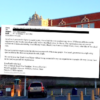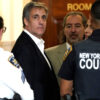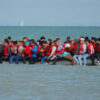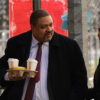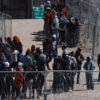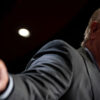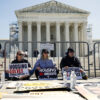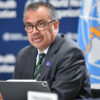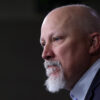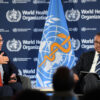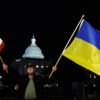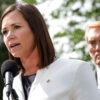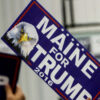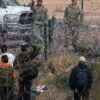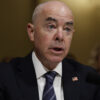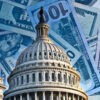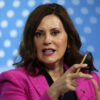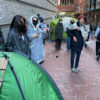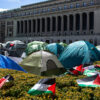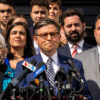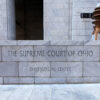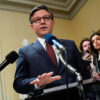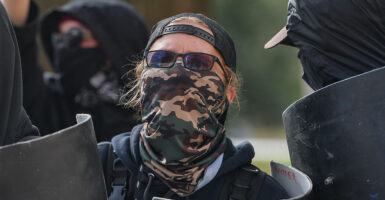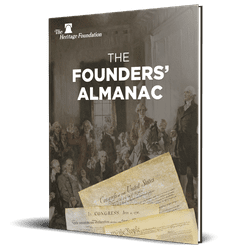In June of 2019, journalist Andy Ngo was attacked and beaten by Antifa. Ngo, the author of the new book “Unmasked: Inside Antifa’s Radical Plan to Destroy Democracy,” joins “The Daily Signal Podcast” to discuss the book, the agenda behind Antifa, the five months of Antifa riots in Portland during the summer of 2020, his on-the-ground investigations in which he actually goes inside the “black bloc” with Antifa members, and much more.
We also cover these stories:
- Former President Donald Trump’s second Senate impeachment trial began Tuesday with a debate on the constitutionality of the trial itself.
- During her confirmation hearing Tuesday, Neera Tanden, President Joe Biden’s choice to head up the Office of Management and Budget, apologized for attacks she has made on Twitter on Republicans.
- COVID-19 is likely to have originated in animals, according to a World Health Organization team tasked with finding the origin of the pandemic’s outbreak.
“The Daily Signal Podcast” is available on Ricochet, Apple Podcasts, Pippa, Google Play, and Stitcher. All of our podcasts can be found at DailySignal.com/podcasts. If you like what you hear, please leave a review. You also can write to us at letters@dailysignal.com.
Rachel del Guidice: I’m joined today on “The Daily Signal Podcast” by Andy Ngo. He’s the editor-at-large for The Post Millennial. As some of you might remember, he also was beaten by Antifa in June of 2019, and has been on our podcast a whole bunch of different times.
So, Andy, it’s great to have you back. Thank you for joining us on “The Daily Signal Podcast.”
Andy Ngo: Thanks for having me on again.
Del Guidice: Well, it’s great to have you with us.
So, I want to dive right in. Congratulations, you just released a new book. It’s called “Unmasked: Inside Antifa’s Radical Plan to Destroy Democracy.” And so we’re going to get into different parts of the book. But can you just tell us a little bit about the book and why you wrote it?
Ngo: I wrote it so that just the average person … would be to pick up one source and have in their hand a book that would provide, not just the history and origins of Antifa, but also lay out what their ideology is, what their strategies are, how they organize, so that people can better understand this threat that we’re dealing with.
There are a lot of misconceptions out there, both on the right and the left. And I think these misconceptions have allowed Antifa to grow as a phenomenon, that now I think is, in some areas of the country, a force that has been destabilizing, as we saw throughout 2020.
My book-writing process took on additional urgency when all of the violence broke out last year in the name of Black Lives Matter. Just because, from city to city, what I was observing in videos, and also when I was there in some places on the ground, was this, in addition to protesters who were saying they were with Black Lives Matter, there were elements within that of people dressed in the black uniforms, and carrying melee weapons, and having backpacks that were filled with Molotov cocktails or other riot supplies.
And they were very strategically and effectively turning these mass, already highly emotionally-charged protests into riots, really at the snap of a finger. And I lay out, in some of the chapters, in my book “Unmasked,” how this process played out, not just in Minnesota, but also in Oregon, and Washington state, and other places.
I think some of the probably most relevant information for readers is some of the primary documents that I released for the first time, from somebody who was in the membership process for one of the largest Antifa groups in the U.S. You will see in there that the curriculum includes the radicalization process that lasts for nearly half the year.
So they really subject their recruits to really intense indoctrination and brainwashing. And, as part of the curriculum, they also train them on how to hurt and maim and injure their opponents, and also how to take up arms.
Del Guidice: That was actually one of my follow-up questions, is you did mention the curriculum used by Antifa. And you had said, in materials for the book, that it includes not only core schedules, but also different meeting locations, individuals involved in training, and that included academics and journalists. So what else can you tell us about this curriculum and how it was used to do this training?
Ngo: So, some of the research that is done at [The Heritage Foundation] looks at the work of jihadist and infamous networks.
And I think it’s analogous to compare what some Antifa groups do to how … this group’s organized, in that they take people who are sympathetic to what they think is the anti-fascist cause. And they befriend them and invite them to social events. And they eventually invite them to join formally, and teach them gradually more and more radical and extreme ideas.
The curriculum is structured in part kind of like a university curriculum, except it lasts for months on end. And they complete different units.
So this curriculum is pretty significant because it was not just used for Rose City Antifa, which is a cell in Portland. But Rose City Antifa is part of this network called the Torch Network. And they’re connected to other cells across the United States, who are organized along similar lines.
It really lays to rest, I hope, in this claim that Antifa are not organized in any meaningful way, that it’s just an ideology of being against fascism.
They have been able to use that as a facade and a way to trick the public into not viewing them as a threat, and viewing them as allies in the fight against the far right, whatever.
In mapping out the growth of the American Antifa, it really exploded in 2016 and going onward.
They’ve existed on the fringes of the far left for several decades in the United States. But 2016 gave them this perfect opportunity to move into the mainstream left, because now they had all these allies in journalism, and culture, and entertainment, who were pumping day in and day out into the minds of the public that America was on the cusp of another Holocaust because of [Donald] Trump’s election win.
Portland really kind of became the sort of testing ground for how far they could go. And the mayor, Ted Wheeler, turned a blind eye, and allowed them to continue to organize, to develop the structures and apparatus.
So I wasn’t particularly surprised that, in 2020, when riots lasted for days in other places around the country, in Portland it lasted for months.
Del Guidice: Something that you bring up in the book, and that some people I don’t think are aware of, is that Antifa actually has some communist roots. Can you tell us about that?
Ngo: Yeah. So part of the origin story of Antifa looks at who are the original Antifa, capital “A.” So the original and first Antifa were a paramilitary group of the German Communist Party, in four years of the Weimar Republic.
And that’s important because, in that historical context, the Antifa today don’t necessarily have a direct lineage to the original group. They kind of just appropriated the name and the symbols and the messaging.
But the original Antifa were communists. The people that they called fascists weren’t just the actual fascists, in terms of national socialists, their opposition was primarily to the Social Democrats, which was the party that was in the governing party of the Weimar Republic. And they saw it at every turn to delegitimize the state. Their members were connected to previous communist uprisings.
Their goal, from the beginning, was always to delegitimize liberal democracy. And the Antifa today still continue that legacy and goal. If you step back, even after World War II, what became East Germany, the communist state of East Germany, they actually institutionalized the so-called anti-fascist ideology into the state ideology.
You can see what that actually produced. It was an extremely repressive society that had a mass spying apparatus that rooted out, not just political dissent, but people who even had wrong things they spied on.
They had hundreds of thousands of informants who were spying on their own family members and all that. And all of this was done in the name of anti-fascism to oppose the West.
The Berlin Wall, as we are familiar with what it’s called, to the East Germans, the official title was the “Anti-Fascist Defense Barrier.”
So this whole label of being against anti-fascism has always been a trick. It sounds noble and great because, I mean, America was involved in a war fighting actual fascists. And so people who are ignorant about Antifa, maybe sympathize with the name, but they use that to pull liberals and the mainstream left into becoming allies or, in my view, useful idiots.
And as I’m writing the book, the ideology, it’s not just cognizance, it’s even worse because it merges in really extreme elements of anarchism as well.
So they’re not just trying to do the tried and true methods of having them be on guard and doing a communist revolution. They don’t recognize any government authorities.
The United States has a history of dealing with far-left Marxist, revolutionary terrorist groups. So you can look at, like, for example, the Weather Underground or the Black Liberation Army. These were communist terrorist groups in the U.S., where you could actually dismantle it, as the federal authorities did in the ’60s and ’70s, by taking out leaders.
Antifa, by the way that it’s structured, and this is where the anarchy comes in, it’s like they’re entirely autonomous and they’re independently organized, connected in networks, but they’re phantom selves, so you cannot take it out in the same way that you could some of these other terrorist communist groups that the U.S. dealt with in the past.
Del Guidice: One of the things that the book covers that you mentioned is that there’s this treasure trove of never before published communications that was sent to Rose City Antifa members in Portland. Can you clue us in on what some of that was?
Ngo: The curriculum is part of that, but also the correspondence between Rose City Antifa and their new member recruits. And they laid out very clearly as, “This is a commitment. You’re expected to complete this curriculum. You’re expected to go to the training.”
Also, the recruits are informed that if they don’t complete the program to the satisfaction of the other members, they can get kicked out, actually.
So the people who go to their recruitment process are not just indoctrinated. They are also expected, eventually, to participate in the criminal activities.
For my sourcing for these primary documents, he made it far into the organization, but was ultimately voted out because his comrades were wondering, “If he’s one of us, why is he not willing to vandalize with us? Why is he not willing to hit and assault other people with us?”
There’s a lot of pressure to not just become like a sympathizer, but to be somebody who will take up arms with their comrades and, if needed, kill and be martyred.
Del Guidice: As you mentioned, Andy, a little bit ago, the book also talks about that five months of Antifa riots in Portland during the summer of 2020. Can you talk us through what happened? You were behind the scenes, undercover there. Can you tell us about what that was like and what you witnessed?
Ngo: People have fresh on their minds the events of the 6th of January at the Capitol, when there was a riot by Trump supporters, and the condemnation of that was unequivocal and universal.
So those, all of those actions on that day, all that and worse, was actually repeated for months on end, every night in my home city of Portland against federal property and also city property and people were at that time silent about that political violence, at best.
At worst, they were actually encouraging of the rioters. And were encouraging people to donate to some of these crowdfunding campaigns, so that rioters could be supplied with travel, accommodation, food, and even riot gear. It was really like a war zone.
So every night the Antifa … were attacking different facilities, but I mean, they were cycling through the same ones.
Most of the violence is directed at the U.S. courthouse in downtown. So it’s a federal building and they had tried to, or they did, actually, set it on fire multiple times with people who were inside. They’d try to barricade the building and then to set it on fire at the same time. They were bringing explosives, guns and knives, Molotov cocktails.
When the federal officers from [the Department of Homeland Security] came to protect this courthouse, they set up a big, heavy fence, similar to the fencing that’s in D.C. now. They set that up around the courthouse and then so the rioters, the Antifa, what they were doing, they started to bring in electric tools to cut into this fence.
So really, it looked like a war zone. It didn’t look like America to me. It looked like something you would see in a failed state where you were having thousands of, essentially, armed militias trying to kill those who are affiliated with the state.
This continued night after night, after night.
The response from the local elected officials like Ted Wheeler and those on City Council was to condemn law enforcement and to also pass new laws that prohibited local law enforcement from even having any communication with the federal law enforcement.
And the press demonized the officers at the time and dozens and dozens of officers faced really serious injuries.
So, I was observing the violence, but what was fascinating to me was the level of sophistication that took place. And I write about this in the book.
It was like an organized army, in that they were divided into different units. So the very front were human body shields.
Sometimes they would put kids in the front or parents would bring their kids and they’d stand in the front and there [was] the Wall of Moms, which you heard a lot about in media. They had veterans in the front and dads.
And then just behind them would be the people who are throwing the projectiles and throwing the explosives. And then much further back would be this whole unit of people with the really powerful lasers. And they would, dozens of them would, focus on one officer. And that would cause eye damage, these lasers. …
Ken Cuccinelli, of the DHS at the time, when he gave testimony to Congress, I would say, he showed even just shining the light for a few seconds on your hand, it will start to hurt because the heat builds up. So imagine dozens and dozens of people directing that at the eyes of these officers.
Then when the law enforcement were forced to respond with tear gas or flash bangs, whatever, to disperse the rioters, because they were actually beginning to break into their area, then all the video cameras by the so-called press would focus then on these civilians who looked like they were getting tear-gassed, and the narrative that was being told over and over that peaceful protesters were being victimized and brutalized by Trump’s secret police Gestapo.
All of that insundry rhetoric brought in people from other cities who came. We had an issue in June where it was hundreds and hundreds of rioters, but by July, because of the false stories that were put out by journalists, that number swelled to the thousands.
Del Guidice: That is an incredible. We’re talking about, for anyone who’s missed the title of the book, the book that Andy has just published is “Unmasked: Inside Antifa’s Radical Plan to Destroy Democracy.”
Something else that you point out in the book is that a lot of people assume that with former President Donald Trump’s exit from the Oval Office, the loss of their right-ring target will cause Antifa to just kind of fade into the background. Is that the case?
Ngo: No, not at all. The opposition to Trump—or, in the words of Antifa, “The fascist Trump regime”—that was always pretextual.
And they played on colleagues in journalism like a fiddle, and they use this whole fearmongering narrative that was pumped out day in and day out to legitimize their messaging. And it had really nothing to do with Trump; that was always an excuse.
Antifa’s main enemy is the United States itself. You can look at their own literature. They viewed the United States as a fascist, imperialistic state, [that] doesn’t just need to be destroyed, but the American philosophy itself needs to be destroyed because America has influenced and exported liberal democracy to a lot of the world in the 20th century.
So that is their principal enemy. So the actions that they were partaking in during the Trump administration are the same in the Biden administration.
Even in November, when it was announced that Joe Biden had become president-elect, the response in the Antifa, in Portland, in Seattle, where they’re most active, [was] to take to the streets to riot.
On the 4th of November, the day after the election, the National Guard was actually activated for the first time by the Oregon governor because the Antifa were … smashing up businesses, one by one, in downtown.
They even destroyed a church, which I think that should have been more widely covered in the media because the destruction of the house of worship, that’s significant, I think.
And they continued that since, but the media had just moved on from Portland. The headlines aren’t so interesting when you can’t blame Trump, when you can’t blame secret police under Trump. So, much of the country wasn’t even aware that the riots were continuing on Inauguration Day in Portland.
The Antifa had announced way ahead of time that they were planning a direct action and, of course, they gathered a group of several hundred, and they marched to the headquarters of the Democrat Party in Portland and destroyed it. And this is the second time that they had severely damaged a building connected to the Democrat Party.
So they literally have chased the mayor of Portland outside of his home. He fled his condo when they rioted out there multiple times and tried to set the building on fire. They’ve assaulted him when they’ve seen him in restaurants.
So these feckless, weak politicians who have coddled and allowed this extremism to grow under their watch, now it’s turned on them, which was a given, anyways. Antifa don’t recognize any political leader.
For example, Jenny Durkan, the mayor of Seattle, she allowed the autonomous zone, the CHAZ, in Seattle to happen for three weeks. I was there, and that devolved into shootings and murders. She announced she’s not running for office again.
These politicians, once they’re done being in office, they can retire and have a good life in a suburb. They’re not affected by the decisions that they made that are turning parts of their cities into First World slums.
Del Guidice: Something that we mentioned briefly was the situation at the Capitol, the riot on January 6th, and something that we’ve talked about is how that you don’t think Antifa was involved in that at all. Can you tell us about that and your perspective there?
Ngo: There were a lot of rumors spreading in real time on the 6th of January, and there [were] a lot of theories that this was a false flag operation by people on the far-left, whether it be BLM or Antifa.
I was very skeptical of that because the type of organization that it would take to embed yourself with, let’s say, Trump supporters and to manipulate them in that way, I haven’t seen Antifa been able to do that.
They’ve been able to do that with people who share similar ideologies to them like BLM protesters and all that, but to carry out that type of complicated operation at a Trump rally, it was hard to swallow. And then the evidence didn’t materialize either.
I was one of the early ones to point out that one of the people who was inside the Capitol Hill, his name is John Earle Sullivan, is somebody who is involved in BLM activism in Utah and had been arrested last year over a riot, but that’s just one person.
The investigations are still ongoing, and so, if new evidence comes out that we find out at a later point, when all these trials play out, that there were other political ideologies present, than we should discuss it then. As of now, there isn’t evidence for that, so I think there needs to be sober analysis by people on what happened.
And I’m really glad that the combination of those actions were universal. I just wish that Democrats and the media were condemning the similar actions that had occurred for much longer last year.
Del Guidice: We’ve talked about the media a little bit, but I did want to ask you, what is your perspective of the media’s coverage in total of Antifa?
Ngo: One reason why I sought to write this book was because the mainstream and legacy media have not done the public right in informing them on what Antifa actually are. And I think that is mostly due out of ignorance.
Antifa, as a movement, an ideology, is relatively difficult to understand … I mean, they do organize as phantom selves, … so there’s always plausible deniability in their presence and role in riots, for example.
And they really exploit that in the press. These are people who I call like the useful idiots, people who just take Antifa on the surface level and think they’re anti-fascists. I think CNN’s Chris Cuomo and Don Lemon are probably some of the most egregious examples.
But there are also journalists who are actual fellow travelers and members of Antifa groups as well. And I write about that in the book.
One of the people who provided some of the radicalization training to Rose City Antifa was a man named Shane Burley. And he has written opinion pieces for NBC, The Independent, and some other mainstream places. And he’s never been forthcoming about his involvement in training Antifa and extremist ideology. So, there’s also academics who are involved.
So, yeah, the press has been abysmal in their coverage of this. And which is why, for example, the problem is as bad as it is.
Del Guidice: Lastly, Andy, I did want to ask you, what do you think? Is there anything Americans can do as well as other leaders and different lawmakers, state and locally, even on the federal level, to respond to Antifa?
Ngo: I’ve been thinking about this lot. And I wanted to en masse to end in some type of positive note, but I do think the present and the near future is bleak in that the conditions that gave rise to Antifa are still there. And confronting these networks and now much most sophisticated apparatuses that develop is much, much harder.
Really, to break up some of these networks, because it involves interstate communications, interstate criminal activities and organizing, it does take a federal response, but I’m not optimistic that the current administration will have the political will to do that.
Even the previous administration under Donald Trump, who is calling Antifa a terrorist organization, all that, the [Justice Department] was not able to, as far as I know, make any effort or inroads into actually breaking up some of these networks.
Some individuals are in the process of being held accountable in that they have trials upcoming for their alleged involvement in far-left riots last year. But you can take out individuals many, many times, it won’t affect the networks because these riots, particularly how they were so effective is that they involved a lot of people who weren’t in Antifa, who are used as foot soldiers unwillingly.
For example, I write about in the book, like what I was seeing in some of these places is that they were at some of these BLM riots.
These people dressed in black would seek out, for example, youths, young people who are just there, sort of as kind of opportunist taking control or taking advantage of the chaos. And they would give them fodder to start fires.
So they would hand them out, actually, some of their modified homemade explosives and tell them to light it and throw in this direction. So if anybody ever gets arrested, it’s those people who were caught on camera or security footage throwing the explosives or lighting the fires.
You never find out who was the one who was actually handing it out because they were completely masked and they disappeared.
But yeah, what really needs to happen is, I guess, that local level, if you happen to live in a left-wing monoculture like Portland or Seattle, I don’t think there really is much that can be done.
Part of what has made Antifa such a growing threat is there is a critical mass of support in these areas for the violent actions of these far-left militants. And that’s a very difficult reality to recognize, but you can look, for example, in Portland, in November.
Ted Wheeler was running for reelection and he’s someone who has been coddling Antifa. And he was considered the moderate choice. He was running against somebody who called herself an Antifa mayoral candidate, who refused to condemn the violence and the riots.
And he only beat her by roughly five points. And only because there was somebody further to her left, who’s running as a write-in candidate, who got around 13% of the votes.
So there is a certain number percentage-wise of people who support [Antifa]. And I don’t know what can be done if you happen to live in it, because these people then will elect district attorneys who are corrupt, as that’s happened in Portland with District Attorney Mike Schmidt who has dropped the charges in more than 90% of the thousand-plus cases of people who have been arrested at the months of riots. …
I’m sorry that I don’t have, like, steps one, two, three of what you can do to improve things. Hopefully, if you have the resources to be able to move to a place where people are more sensible and elect people who are actually willing to uphold the rule of law.
Del Guidice: For those who want to read the book, it’s called “Unmasked: Inside Antifa’s Radical Plan to Destroy Democracy.” Andy, thank you again for coming on the podcast and speaking with us today. It’s always great having you here.
Ngo: Thank you.

